Structured Teaching: an overview
Structured Teaching is a set of teaching techniques developed by Division TEACCH (Training and Education of Autistic and related Communication-handicapped Children), a state-wide program serving individuals with autism spectrum disorders (ASD) in North Carolina.
These teaching strategies are based on an understanding of how autism impacts the thinking, learning, and behavior of an individual with ASD. Differences in auditory processing, imitation, motivation, and organization can hinder the educational success of students with ASD, as most traditional teaching strategies rely heavily on verbal instructions, demonstration, social reinforcement, and sequencing chunks of information or directives.
Structured Teaching strategies, however, capitalize on the strengths of students with ASD. These include providing predictable and meaningful routines through the use of structure, adding visual/structural supports to classroom instruction and activities to increase engagement and independence, and clearly organizing classroom spaces and teaching materials to reduce anxiety and increase appropriate behavior.
There are five elements of Structured Teaching that build on one another, and all emphasize the importance of predictability and flexible routines in the classroom setting. Division TEACCH developed a visual to illustrate the Structured Teaching components — the Structured Teaching pyramid:
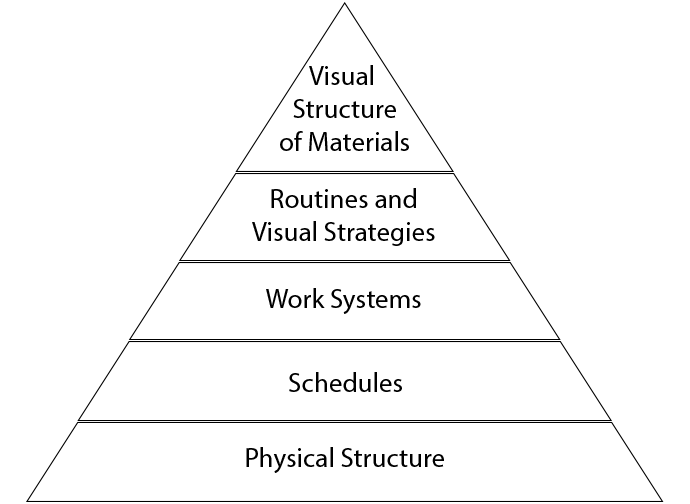
This article focuses on visual structure in the school setting.
What is visual structure?
Visual structure adds a physical or visual component to tasks to assist students in understanding HOW an activity should be completed. Because students with ASD are less likely to be successful with only oral directions, visual structure adds a tangible component to an activity to increase meaning and understanding. Visual structure also helps a student increase attention, engagement with materials, and allows students to locate the most relevant information while completing his/her work. Visual structure has three components (Mesibov, Shea, & Schopler, 2005):
- Visual Instructions: Tells the student where to begin and the sequence of steps to complete an activity
- Visual Organization: How the space and materials are limited or arranged
- Visual Clarity: Emphasizes or draws attention to important or relevant information
Why do I use visual structure with students with ASD?
Engagement of students with ASD is less likely unless careful planning in the design of educational materials and activities occurs. Traditional teaching procedures and resources, such as standard lectures and worksheets, may not be appealing or easy to understand for students with ASD. Several additional considerations may be required.
There is substantial evidence that students with ASD have strengths in processing visual information in comparison to processing language or auditory information (Mesibov et al., 2005; Quill, 1997). When instructions related to a task or assignment are given verbally, students with ASD may have difficulty understanding and responding quickly and appropriately. Providing the information visually, embedded within the activity, instead allows students to continually refer to instructions and have a clearer understanding of what is expected. Providing information visually capitalizes on the strengths of students and provides more opportunities for the student to practice the skill independently (without relying on verbal directives from staff).
Students with ASD may have greater difficulty in organizing and sequencing materials due to deficits in executive functioning (Mesibov et al., 2005) and/or challenges in modulating sensory input. Worksheets with a great deal of information, or large quantities of materials that may fall or become mixed together may be distracting or overwhelming for students. It is often necessary for staff members to assist in organizing materials, and to present them in a minimally stimulating manner. The placement of materials in containers, folders, baskets, or trays may be beneficial. Limiting the amount of information and size of the work space to reduce stimulation may also be helpful.
Students with ASD may also have difficulty interpreting the importance of information and give undue attention to details (Mesibov et al., 2005). It may be necessary to emphasize the most important aspects of the task or activity in an effort to make the meaning more salient. This may require the use of color coding, numbering, highlighting, or adding additional visual cues.
Along with visual structure, incorporating the unique interests of students with ASD into the content and/or layout of instructional activities is another strategy to increase both engagement and meaning. Capitalizing on student interests can provide motivation to complete activities, and students may find the activities more reinforcing than traditional social reinforcement from staff members or peers. The areas of interest may be incorporated subtly (i.e. picture of a Power Puff girl hidden on each text book page) or overt (i.e. the content of the word problems is related to Power Puff girls).
How do I implement visual structure?
When designing activities for individuals with autism it is important to first consider how instructions will be provided. It is essential to supplement verbal directives with visual information. This allows students to function more independently, as they can be taught to look to the materials for information, rather than relying solely on a staff member to guide the individual through the task. Supplementing instructions with visuals also helps to teach students that materials can be used for multiple purposes. For example, students can learn through visual instructions that the small colored bears can be used sometimes for sorting colors, other times for patterning, and another time for counting. Visual instructions can be provided in a variety of ways depending on what the needs of the student are and the student’s functioning level. For the most concrete learners, the materials themselves provide the instruction information, and for students who understand pictures/words, those abstract systems can provide instructions.
For example:
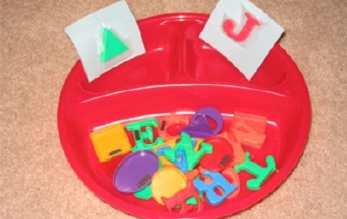 |
The materials define the task. |
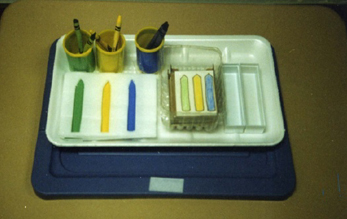 |
A jig shows the layout of materials in their correct sequence |
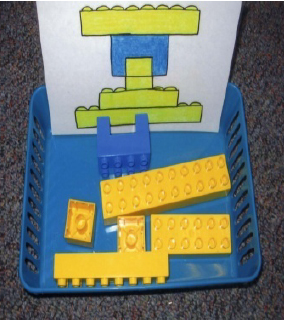 |
A product sample |
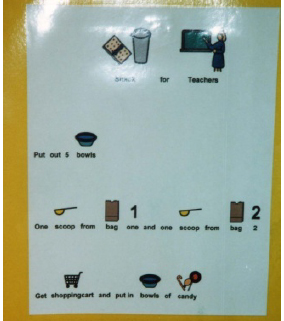 |
A written list with pictures |
Next, it is important to decide what types of organization may need to be incorporated into the activity to allow the student to be more successful and independent. It is helpful to consider stabilizing materials, containing task materials in/on a tray, limiting the number of parts or pieces, and setting up some of the task for the student ahead of time.
For example:
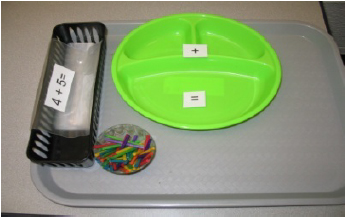 |
Organization of math task: materials are placed in containers and stabilized on tray; work space is defined; materials are limited. |
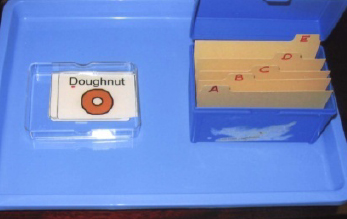 |
Organization of an alphabetizing activity: materials are placed in containers and stabilized on tray; limited letters (A-E); no extraneous information; work space is defined. |
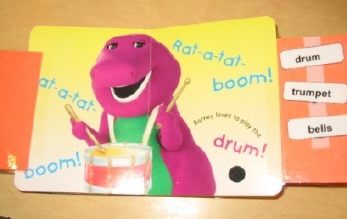 |
Organization of a reading activity: materials are self-contained in a book (extra flap added to each page for pieces); work space is defined; all materials are stabilized on pages. |
 |
Organization of a math worksheet: limited number of problems and limited amount of space; worksheet is organized so student knows where to put responses. |
In addition, it is helpful to provide additional clarity to students to help identify what is most important.
For example:
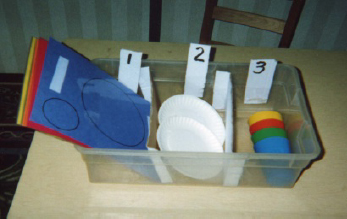 |
Clarifying the sequence of steps: numbers (along with the container) are used to identify the order of steps in setting the table. |
 |
Clarifying the item to recycle: both pictures and an example of the actual object are used to highlight what item should be placed in each drawer. |
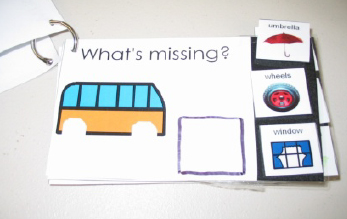 |
Clarifying where the student response should go: the black box indicates where the student should put his/her answer. |
Finally, when designing teaching materials for your students with ASD, it is helpful to include student interest to increase meaning and motivation. It may not be feasible to incorporate student interest in every activity, however, designing a number of highly motivating tasks to intersperse in a work session may assist students in starting their work more successfully and in maintaining on-task behavior throughout.
For example:
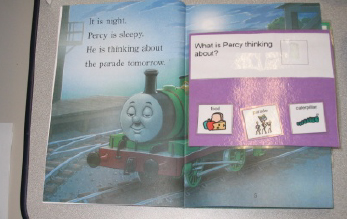 |
Reading comprehension activity using Thomas the Train. |
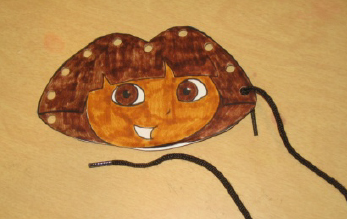 |
Fine motor lacing activity incorporating Dora the Explorer. |
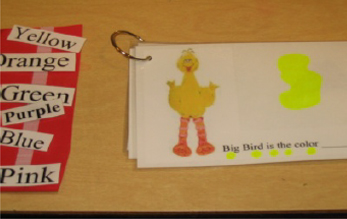 |
Reading comprehension activity using Sesame Street. |
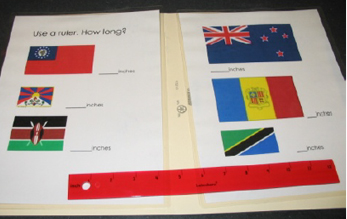 |
Measuring activity using flags- a student interest. |
Tips for implementing visual structure
- Think about how materials can be used across curricular areas or for more than one purpose to ensure the most use.
- Think creatively about how activities can be made. Use parent volunteers, student helpers, scout troops, and/or community members.
- Consider how you might share resources with other teachers or create an activity lending library in your building/district.
- Instructional activities should relate to your individual assessments of student needs and the curriculum used by your school/state.
